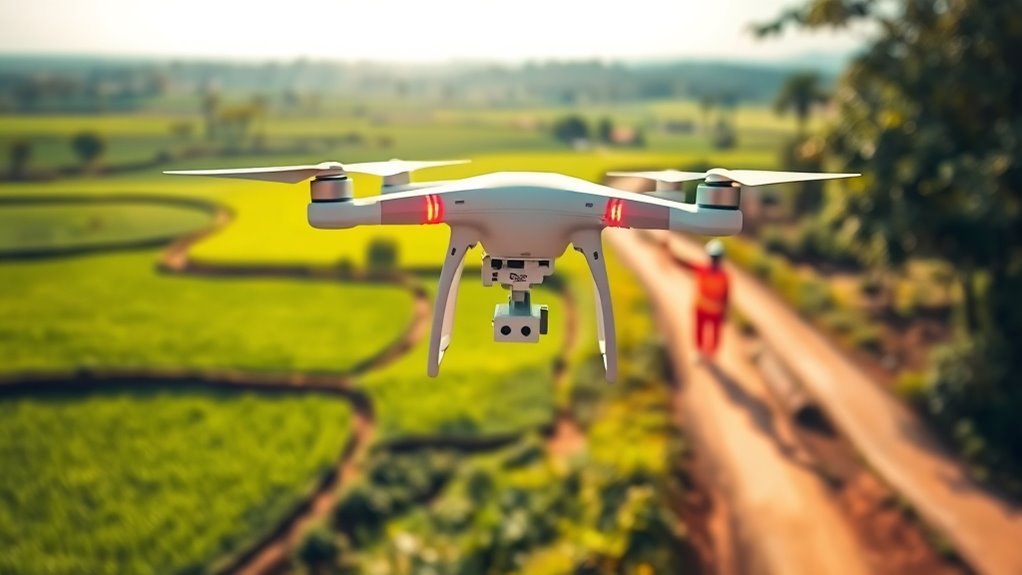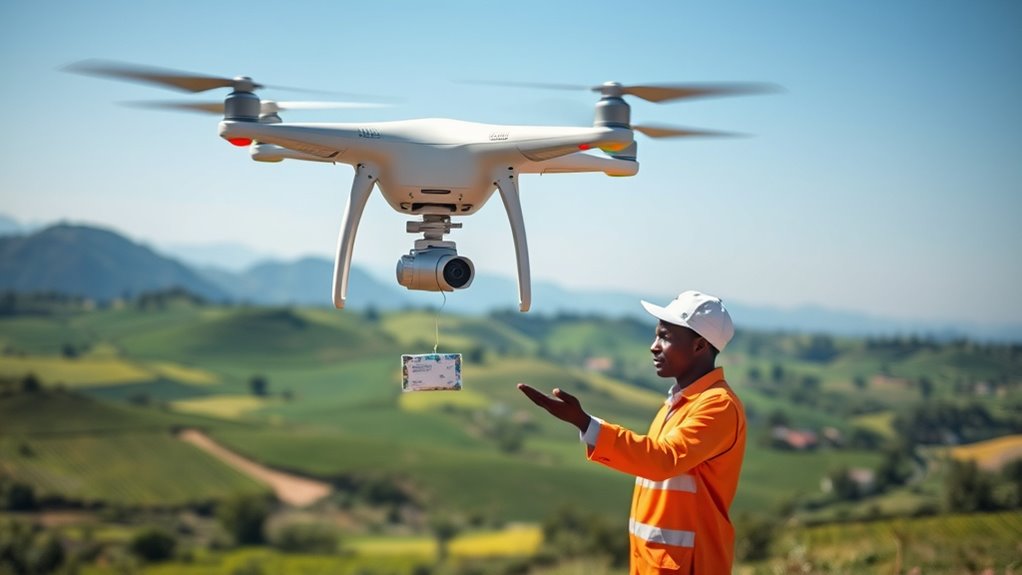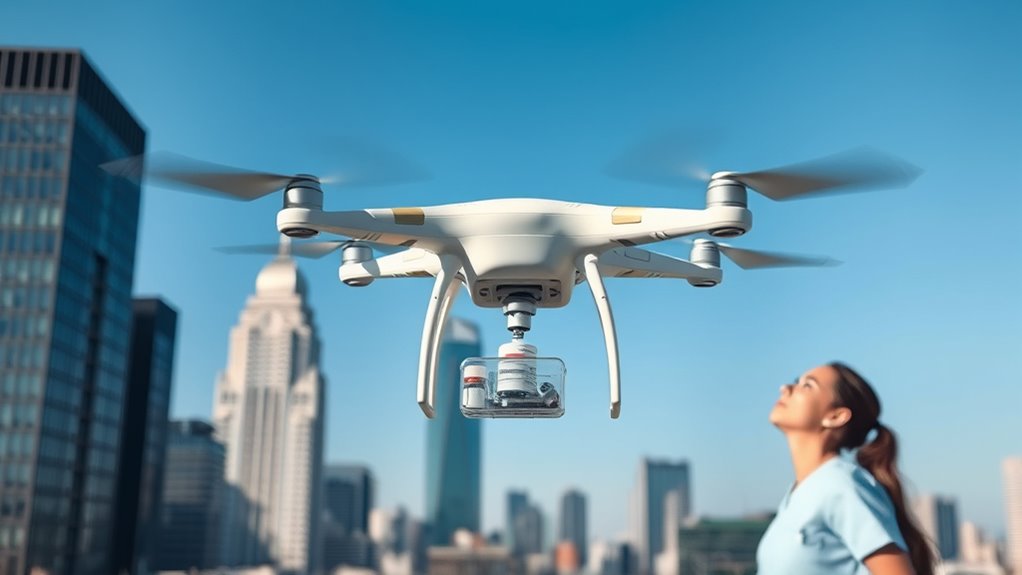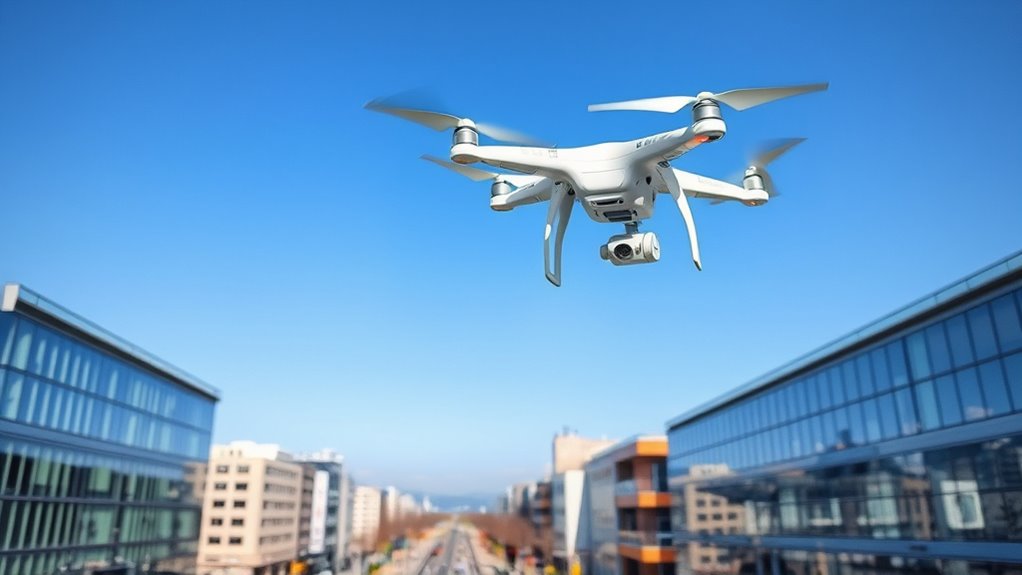Drones are transforming medication delivery by providing fast, reliable access to essential medicines, especially in remote or hard-to-reach areas. They bypass traffic delays, reduce transportation costs, and support urgent responses during health crises like Ebola and COVID-19. Globally, they’ve helped deliver vaccines and supplies to millions, including islands and mountainous regions. As this technology advances with smarter navigation and cold chain solutions, you’ll discover how it’s shaping the future of healthcare delivery.
Key Takeaways
- Drones enable rapid delivery of medications and vaccines, especially in remote or inaccessible areas, reducing response times to under 60 minutes.
- They help overcome infrastructure challenges, reaching islands, mountainous regions, and disaster zones efficiently.
- Drone logistics improve healthcare access during outbreaks like Ebola and COVID-19 by ensuring timely delivery of essential supplies.
- Innovations include larger payload capacities, longer ranges, autonomous navigation, and cold chain-preserving technology.
- Regulatory and safety challenges are being addressed through urban air traffic management protocols and advanced tracking systems.
The Growing Role of Drone Technology in Healthcare

Drone technology is rapidly transforming healthcare by making the delivery of medications and medical supplies more efficient and accessible. Drones are now helping healthcare providers reach remote or inaccessible areas quickly, ensuring patients get what they need faster.
Drone tech is revolutionizing healthcare by enabling faster, more accessible delivery of medications and supplies.
WellSpan Health in Pennsylvania partners with Zipline to deliver prescriptions directly to patients’ homes, demonstrating how drones can scale healthcare logistics.
In Texas, Amazon Pharmacy has been operating drone deliveries since October, providing medications within 60 minutes of ordering.
Major institutions like Cleveland Clinic and Massachusetts General Brigham are exploring drone services to improve medication access and cut urban traffic delays.
Drones offer faster delivery times, lower costs, and better access, especially in rural, urban, or disaster-affected regions, revolutionizing healthcare delivery worldwide.
Key Benefits of Using Drones for Medical Supplies

Using drones for medical supplies means you get urgent medications delivered within an hour, saving valuable time. They can navigate through traffic and reach remote areas where traditional transport struggles. This rapid, reliable delivery helps improve patient outcomes and healthcare access overall. Additionally, the implementation of robust security measures ensures that sensitive medical data remains protected during the delivery process. Drones can also transport essential medical supplies such as vaccines and blood products, further enhancing their utility in healthcare logistics. Furthermore, the efficiency of drone delivery can significantly reduce transportation delays that often hinder timely medical interventions. Moreover, utilizing drones aligns with the principles of sustainable healthcare logistics, promoting efficiency and reducing environmental impact. With their ability to reach various locations, drones can also support home gardening initiatives by delivering supplies directly to patients’ homes.
Rapid Delivery Speeds
One of the greatest advantages of drone technology in medical delivery is their ability to reach patients quickly, often within 60 minutes in some cases. This rapid delivery speed is a game-changer, especially when time is critical. Drones can bypass traffic congestion and other delays by flying directly to their destination, reducing transit times considerably. Incorporating efficient energy use in drone operations aligns with sustainability goals, promoting eco-friendly practices in logistics. Additionally, drones can operate in various environments, making them suitable for remote delivery locations, further enhancing their utility in medical supply chains.
In countries like Malawi, drone programs have delivered essential medicines to nearly 20 million people, showcasing how fast access can be achieved in underserved areas. During the COVID-19 pandemic, drones transported millions of vaccines worldwide, ensuring speedy distribution to those in need. This real-time, on-demand delivery capability means you get urgent medications faster, helping save lives and improve patient outcomes. Moreover, integrating natural materials into drone design can enhance their efficiency and performance, ensuring a more sustainable approach to medical logistics. The use of eco-friendly options in drone manufacturing can significantly reduce the environmental impact associated with traditional logistics methods. Furthermore, the impact of divorce in the Philippines illustrates how rapid changes in societal structures can lead to innovative solutions like drone delivery systems in healthcare.
Enhanced Access in Remote Areas
The speed and agility of drone technology make it possible to reach areas where traditional transportation falls short. You can now deliver medical supplies to remote and hard-to-reach locations like islands and mountainous regions, where roads are scarce or nonexistent. Regular maintenance of drone equipment ensures reliable operations during critical deliveries. Additionally, implementing required minimum distributions can help ensure that these vital supplies are consistently available in underserved areas. The integration of best safety glasses for 2024 into drone delivery operations can enhance the safety of personnel involved in these critical missions.
Drones have proven especially valuable in healthcare logistics, ensuring timely access to essential medications and vaccines. For example, in Malawi, drone networks serve nearly 20 million people in rural communities without reliable roads, while during Ebola outbreaks, drones cut delivery times from days to hours. This technology bridges geographical gaps, enabling healthcare providers to serve even the most isolated populations. Moreover, using drones increases access to essential medications, which is crucial in emergency situations. This innovative approach draws parallels to how canine affection and love can enhance the bond between humans, showcasing the importance of connection even in critical times.
- Overcoming infrastructure challenges in rural regions
- Rapidly delivering medicines to disaster zones
- Ensuring vaccine access in remote islands
Overcoming Challenges in Drone-Based Medical Delivery

Overcoming challenges in drone-based medical delivery requires addressing a complex web of regulatory, technical, and privacy concerns. Regulatory hurdles and airspace management are major obstacles, especially in urban areas where drone traffic needs strict coordination. You must develop standardized protocols and secure regulatory approval to navigate legal barriers. Additionally, understanding current news in Indonesia can provide insights into the evolving landscape of drone regulations and their impact on healthcare delivery. Implementing energy-efficient appliances in drone stations can help reduce operational costs and improve sustainability. Furthermore, the use of electricity production from bike generators can demonstrate innovative energy solutions for powering drone operations.
Ensuring cold chain integrity during flight demands advanced refrigeration and real-time monitoring systems, which add technical complexity. Privacy concerns also arise if sensitive health information gets compromised during drone operations, risking HIPAA violations.
Technical issues like drone malfunctions, crashes, or tampering threaten safety and reliability. To succeed, you need to implement robust safety measures, streamline regulations, and enhance airspace management strategies, making sure that these solutions work seamlessly and securely for effective medical deliveries. Additionally, the use of necessary cookies on delivery platforms can help ensure compliance with privacy regulations while enhancing user experience.
Global Examples of Drone Deployment in Medical Missions

Around the world, drones are transforming healthcare by reaching remote areas and controlling infectious diseases. You see examples in Malawi, where they deliver supplies to millions, and in the Democratic Republic of Congo, where they transport vaccines to fight Ebola. These deployments show how drones can improve access and support disease control in challenging environments. Additionally, the integration of drones into health systems is reminiscent of real tales of Cold War agents who utilized innovative technology for covert missions. This innovative approach reflects how constraints can inspire innovative solutions, ultimately enhancing the effectiveness of medical missions. Furthermore, the use of drones aligns with AI-driven diagnostics that improve healthcare delivery efficiency and accuracy. Notably, the lightweight design of Chinese corrugated rolls used for packaging medical supplies further enhances the logistics of drone deliveries. Moreover, the use of drones for medication delivery demonstrates the environmentally friendly potential of modern technologies in reducing carbon footprints associated with traditional transportation methods.
Remote Area Access
Have you ever wondered how medical supplies reach the most isolated communities? Drone technology revolutionizes remote area access by bypassing difficult terrain and infrastructure limitations, transforming healthcare systems worldwide.
In Malawi, drones deliver essential medicines to nearly 20 million people living in remote villages, drastically improving healthcare outreach.
The Democratic Republic of Congo uses drone programs to transport vaccines and medical equipment, supporting disease control efforts like Ebola.
Across 83 islands in the South Pacific, drone deliveries ensure timely access to vaccines while reducing waste.
During the COVID-19 pandemic, drones delivered millions of vaccines to underserved populations globally.
These initiatives demonstrate how drones expand healthcare reach, guaranteeing vital supplies reach even the most inaccessible areas swiftly and reliably. Furthermore, the best practices in drone deployment are crucial for maximizing efficiency and effectiveness in medical missions.
Disease Control Missions
How are drones transforming disease control efforts worldwide? Drones enable healthcare providers to deliver essential supplies rapidly, even in remote or hard-hit areas. In Malawi, they’ve reached nearly 20 million people, improving access to medicines and diagnostics.
In the Democratic Republic of Congo, drones quickly transport test samples and vaccines, critical during Ebola outbreaks. Over 83 islands in the South Pacific, drones deliver vaccines and reduce medical waste, ensuring isolated populations receive proper care.
During the COVID-19 pandemic, drone programs globally helped deliver millions of vaccines, strengthening immunization efforts in hard-to-reach regions. These deployments drastically cut delivery times, making emergency responses more efficient.
Innovations and Future Trends in Drone Healthcare Logistics

Innovations in drone technology are transforming healthcare logistics by enabling larger payloads and longer flight ranges, which allow for more efficient delivery of medications and vaccines.
Advances in systems and drone technology now support autonomous navigation, improving precision and reliability in complex urban and rural environments.
Real-time tracking coupled with secure data encryption guarantees confidentiality and maintains the chain of custody during transport.
Future trends include developing urban air traffic management protocols to support large-scale drone deployment for healthcare needs.
Additionally, innovations such as cold chain-preserving drones aim to expand the delivery of temperature-sensitive medications worldwide.
These advancements will enhance the capacity, safety, and scalability of drone-based healthcare logistics, fundamentally reshaping how medical supplies reach communities.
Making Healthcare More Accessible Through Aerial Delivery Systems

Advancements in drone technology are now making healthcare more accessible by reaching communities that traditional delivery methods struggle to serve. The integration of autonomous drones in drone delivery allows quick, reliable access to medications and vaccines in remote and inaccessible areas. This technology bypasses urban traffic congestion, ensuring faster delivery of life-saving medicines and lab samples.
Pilot programs by companies like Zipline and Amazon Pharmacy demonstrate that prescriptions can arrive within 60 minutes, highlighting the potential for rapid healthcare response. Drone delivery reduces logistical barriers and transportation costs, making medication distribution more sustainable and affordable, especially in rural and underserved regions.
As adoption grows, aerial delivery systems expand healthcare reach, delivering timely treatment and improving patient outcomes worldwide.
Frequently Asked Questions
Can You Use Drone to Deliver Drugs?
You can definitely use drones to deliver drugs. They’re already being tested and used in various settings, like retail pharmacies and hospitals, to get medications to patients faster, especially in remote or traffic-heavy areas.
Drones provide precise, reliable delivery, and safety standards are being developed to guarantee secure transportation. So, yes, drone delivery of drugs isn’t only possible but increasingly practical and effective.
What Company Is Using Drones to Deliver Packages?
You’re curious about which companies are using drones to deliver packages. Right now, Amazon Pharmacy is delivering prescriptions via drones in parts of Texas, arriving within an hour.
Zipline partners with healthcare providers like Cleveland Clinic to deliver medical supplies and medications.
Massachusetts General Brigham plans to launch its own drone service in Boston for home hospital deliveries.
These companies use advanced autonomous drones to make fast, reliable deliveries directly to your doorstep.
How Much Does Drone Delivery Cost?
You’re wondering about drone delivery costs. Currently, it ranges from $10 to $50 per delivery, influenced by distance, payload, and provider.
Pilot programs like Amazon’s report costs around $10 to $20, which could drop as technology improves.
While more expensive than traditional methods now, costs are expected to decrease with larger-scale use and infrastructure growth, making drone delivery more affordable over time.
Who Are the Big 3 in US Drone Delivery?
When you ask about the big 3 in US drone delivery, you’re looking at Amazon, Zipline, and Wing. These companies lead the industry by pioneering drone technology, expanding delivery services, and working with regulators.
Amazon is notable for its retail prescription deliveries.
Zipline partners with healthcare providers.
Wing focuses on rapid parcel and medication deliveries.
These giants are shaping the future of drone logistics across the US.
Conclusion
As drone technology soars into the future, it’s transforming healthcare like a rising tide lifting all boats. You’re on the brink of a new era where life-saving medications reach even the most remote corners with ease. Embracing these innovations, you become part of a movement that’s breaking down barriers and making healthcare accessible to everyone. Together, we’re charting a course toward a world where aerial delivery isn’t just a promise—it’s a reality that saves lives every day.









